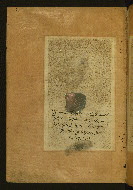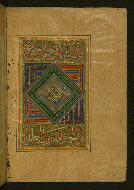Home > Digitized Walters Manuscripts
This document is a tranformation of a TEI P5 XML manuscript description incorporating images. If you have trouble reading special or non-Latin characters on this page, please make sure you have appropriate Unicode fonts installed and an up-to-date web browser.
Walters Ms. W.578, Prayer
Browse images (Browse images in a new window) | TEI in XML format
W.578
Prayer
Vernacular: حزب البحر
Authority name: Abū al-Ḥasan al-Shādhilī (d. 656 AH / 1258 CE)
As-written name: Abū al-Ḥasan ʿAlī ibn ʿAbd Allāh al-Shādhilī
Name, in vernacular: ابو الحسن علي بن عبد الله الشاذلي
This illuminated manuscript is of the well-known prayer called Ḥizb al-baḥr (Litany of the sea) by Abū al-Ḥasan al-Shādhilī (d. 656 AH / 1258 CE), the founder of the Shādhilīyah sufi order. It was copied in the eleventh century AH / seventeenth CE in Ottoman Turkey. The text, on gold-sprinkled paper with tan tinted margins, is written in a variety of large-size scripts, including thuluth, muḥaqqaq, rayḥān, and tawqīʿ, vocalized in black and blue. Illuminated rosettes with colored dots serve as verse markers.There is a bequest (waqf) statement (fol. 2a) in the name of Sultan ʿUthmān Khān III (reg. 1168-71 AH / 1754-57 CE), signed by Ibrāhīm Ḥanīf, inspector of awqāf. The illuminated finispiece (fol. 7b) is inscribed with the basmalah and ḥamdalah in white thuluth script in horizontal panels that frame a central lozenge containing Qur'anic verses in green and black Square Kufic. The binding of gold-sprinkled pink paper over pasteboard with central lobed gold-tooled medallion dates to the late eleventh century AH / seventeenth CE or the twelfth century AH / eighteenth CE. The fact that the flap is on the wrong side suggests that the manuscript may have been rebound at a later stage.
11th century AH / 17th CE
Turkey
Book
Devotional
The primary language in this manuscript is Arabic.
Paper
Gold-sprinkled paper; tan tinted paper for margins
Foliation: 8
Catchwords: None
21.5 cm wide by 31.5 cm high
12.0 cm wide by 20.0 cm high
- Columns: 1
- Ruled lines: 9
- Text divided into five compartments: three compartments across the written surface and two compartments indented with panels 2 cm in width on each side; framing lines in blue, black, gold, green, and orange
- Title: Ḥizb al-baḥr
- Author: Abū al-Ḥasan al-Shādhilī (d. 656 AH / 1258 CE)
- Incipit: يا الله يا علي يا عظيم...
- Hand note: Written in a number of fully vocalized scripts, including thuluth, naskh, muḥaqqaq, rayḥān, and tawqīʿ
- Decoration note: Full-page illuminated finispiece (fol. 7b); polychrome text (black, blue, gold, and red) divided into compartments using a number of scripts; polychrome text frame; illuminated rosette verse markers with colored dots
fol. 2a:

- Title: Bequest statement with erased seals
- Form: Bequest (waqf) statement
- Label: This bequest (waqf) statement in the name of Sultan ʿUthmān Khān III (reg. 1168-71 AH / 1754-57 CE) is signed by Ibrāhīm Ḥanīf, inspector of awqāf. Seals, apparently of the Sultan and the inspector, are erased.
fol. 7b:

- Title: Illuminated finispiece with doxological formulae and Qur'anic inscriptions
- Form: Finispiece
- Text: Central lozenge contains the Throne Verse (2:255); frame around the lozenge in green and black contains the basmalah followed by Qur'anic verses (45:36-37); triangular segments contain the following Square Kufic inscriptions: (top right) basmalah, (bottom right) Qur'an (112:1-2), (bottom left) Qur'an (112:3-part of 4), (top left) Qur'an (112:4, remaining to the end)
- Label: The top and bottom panels of this illuminated finispiece are inscribed with the basmalah and ḥamdalah in white thuluth script. The Qur'anic verses in the central panel are written in Square Kufic.
The binding is not original.
Late eleventh century AH / seventeenth CE or twelfth century AH / eighteenth CE; gold-sprinkled pink paper over pasteboard (with flap, misbound on wrong side); central lobed medallion in gold-tooled black goatskin with floral design; matching design on flap; pastedowns of marbled paper
Waqf entry in the name of Sultan ʿUthmān Khān III (reg. 1168-71 AH / 1754-57 CE), son of Muṣṭafá II, signed by Ibrāhīm Ḥanīf, inspector of awqāf (fol. 2a); seals of the Sultan and the inspector erased
Walters Art Museum, 1931, by Henry Walters bequest
Brockelmann, Carl. Geschichte der arabischen Litteratur (New York; Köln: E.J. Brill, 1996), 1: 584; S1: 805.
Principal cataloger: Gacek, Adam
Catalogers: Landau, Amy; Smith, Sita
Editor: Bockrath, Diane
Conservators: Jewell, Stephanie; Quandt, Abigail
Contributors: Barrera, Christina; Emery, Doug; Herbert, Lynley; Noel, William; Simpson, Shreve; Tabritha, Ariel; Toth, Michael B.; Valle, Chiara
The Walters Art Museum
Licensed for use under Creative Commons Attribution-NonCommercial-ShareAlike 3.0 Unported Access Rights, http://creativecommons.org/licenses/by-nc-sa/3.0/legalcode. It is requested that copies of any published articles based on the information in this data set be sent to the curator of manuscripts, The Walters Art Museum, 600 North Charles Street, Baltimore MD 21201.